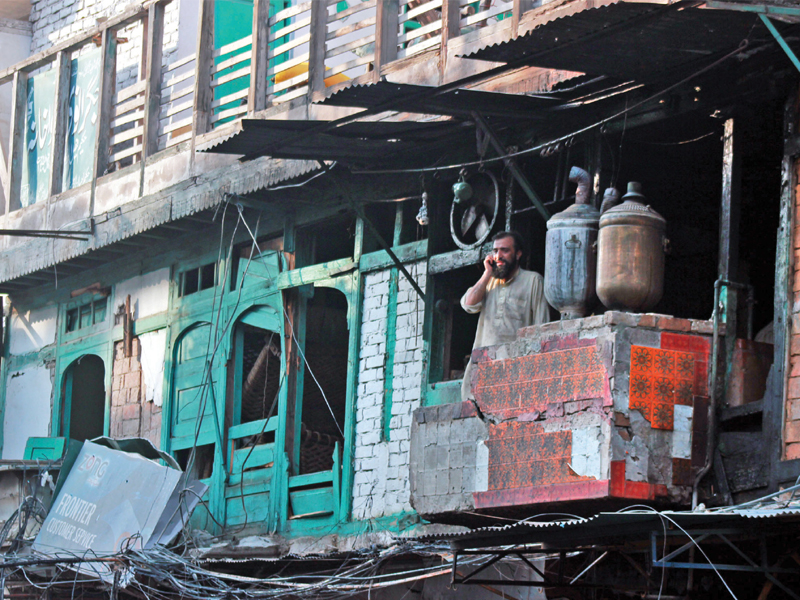
When Henry George Raverty described Qissa Khwani in the 1850s as the liveliest part of Peshawar, he was not far off the mark.
What Raverty had witnessed 160 years ago was a crowded Qissa Khwani in the captivating glow of the golden hour as caravans made their way towards the street’s offerings – food stalls and qehwa khanas (tea shops).
The travellers swapped stories of love and war in distant lands over endless cups of qehwa (green tea). The street created bards and spun lore, eventually earning its present moniker – Qissa Khwani Bazaar or ‘the Storyteller’s Market’.
A century and a half later, the bazaar is still the liveliest, albeit the most wounded, part of the city of three million strivers. It is a subject of history, romance and nostalgia but never receded to the footnotes. The tales it offered just morphed into clips of terror and death, feeding the 24-hour news cycle.
The bazaar unfurls from the Kabali police station (now known as Khan Raziq police station) and draws a line at the junction of Misgaran Street and Mohammad Ali Johar Road. No skyscrapers or grand structures dot the street. Only small shops and narrow alleys which go deeper into the lives of the old city.
Perhaps, more than any flashy building, the fact that Qissa Khwani is entangled and enshrined in collective memory is what makes it matter to individuals. In this respect, Qissa Khwani is truly fabled. It is steeped in history, culture and tradition. The houses of Bollywood royalty, old caravan sarais (inns), qehwa khanas of yore and an arched memorial of the 1930s Peshawar massacre, all mark the bazaar.
At a stone’s throw lies Gor Gathri (A warrior’s grave) where archaeologists have carved out Peshawar’s glorious past layer by layer. The remains date back to the Gandhara period when the area was known as “lotus land”.
But the bazaar is not an old lady, living in the past. When dusk falls, Qissa Khwani comes alive with lights, noise and the drama of food. It stands witness to the travails and triumphs of a city which has lived on for the past 2,500 years.
The city’s descent into chaos
Invaders and attackers are not alien to Peshawar. Situated at the crossroads of empires, it has witnessed armies pouring in and heard the music of cavalry horses marching.
Sometimes, the soldiers descended the steppes of Central Asia to attack India and passed through it, or ventured beyond the Khyber Pass into Afghanistan on ‘regime change’ missions.
Then, the city and its populace remained unscathed, earning fond titles such as the “Piccadilly of Central Asia”.
With the Soviet invasion of Afghanistan all that changed. The war invited unmanageable numbers of refugees, fleeing the Red army’s wrath, into Peshawar. The mujahidin followed, then the Taliban to drive “the infidels” out of Afghanistan. They were followed by the USA and its drones.
At the moment, the provincial capital is host to about 2.7 million Afghans and 774,594 internally displaced persons (IDPs), feeding, clothing, marrying and burying them.
Today it is also a city of chaos – of human bombs and explosive-laden vehicles. Now, 11 years into a bloody insurgency, bad days and dark headlines are always part of yesterday and tomorrow.
Every nook and corner of this city has borne the brunt of this shadowy war.
A bleeding heart
“Of all Pathan cities, Peshawar is the unchallenged queen,” wrote American diplomat James W Spain. And now Qissa Khwani is its bleeding heart.
Qissa Khwani and localities surrounding it have seen most sustained and ruthless attacks over the past decade.
Attacks at Meena Bazaar, Chowk Shaheedan, Imambargah Alamdar Karbala, Koocha Dilgaran, Dhaki Nalbandi, Soekarno Square, Cinema Road, Imambargah Qasim Baig, Kabari Bazaar, All Saints’ Church and twice at Kabuli have targeted this centre over the past few years.
Qissa Khwani for some years even remained off-limits for public vehicles due to bomb attacks. Now. upon entering this street, one is greeted by barbed wires meshes. Time and again the bazaar bathes in blood, as politicians continued to shun their responsibility and its guardians are caught off guard.
This seems to be the bloodiest chapter in the living tale of the ‘Storyteller’s Bazaar’.
Published in The Express Tribune, September 30th, 2013.
COMMENTS (2)
Comments are moderated and generally will be posted if they are on-topic and not abusive.
For more information, please see our Comments FAQ


1729662874-0/One-Direction-(1)1729662874-0-165x106.webp)







1726722687-0/Express-Tribune-Web-(9)1726722687-0-270x192.webp)






Manzoor has wonderfully written the past and present of this Bazaar. Qissa Khani Bazaar has lost its past grandeur because of the shift of city towards west, whereas Sadder and University road are new centers for shopping. Whenever I go to Peshawar I avoid passing through this bazaar because of the legacy of explosions there. Still too many folks from lower middle class go there for shopping because they think, it is less expensive than other parts of the city. The non stop detonations will further compel many traders to chose some safe places and consumers will go other directions for the purchase of commodities. In the foreseeable future this bazaar will become only part of history.
May GOD save our pakistan